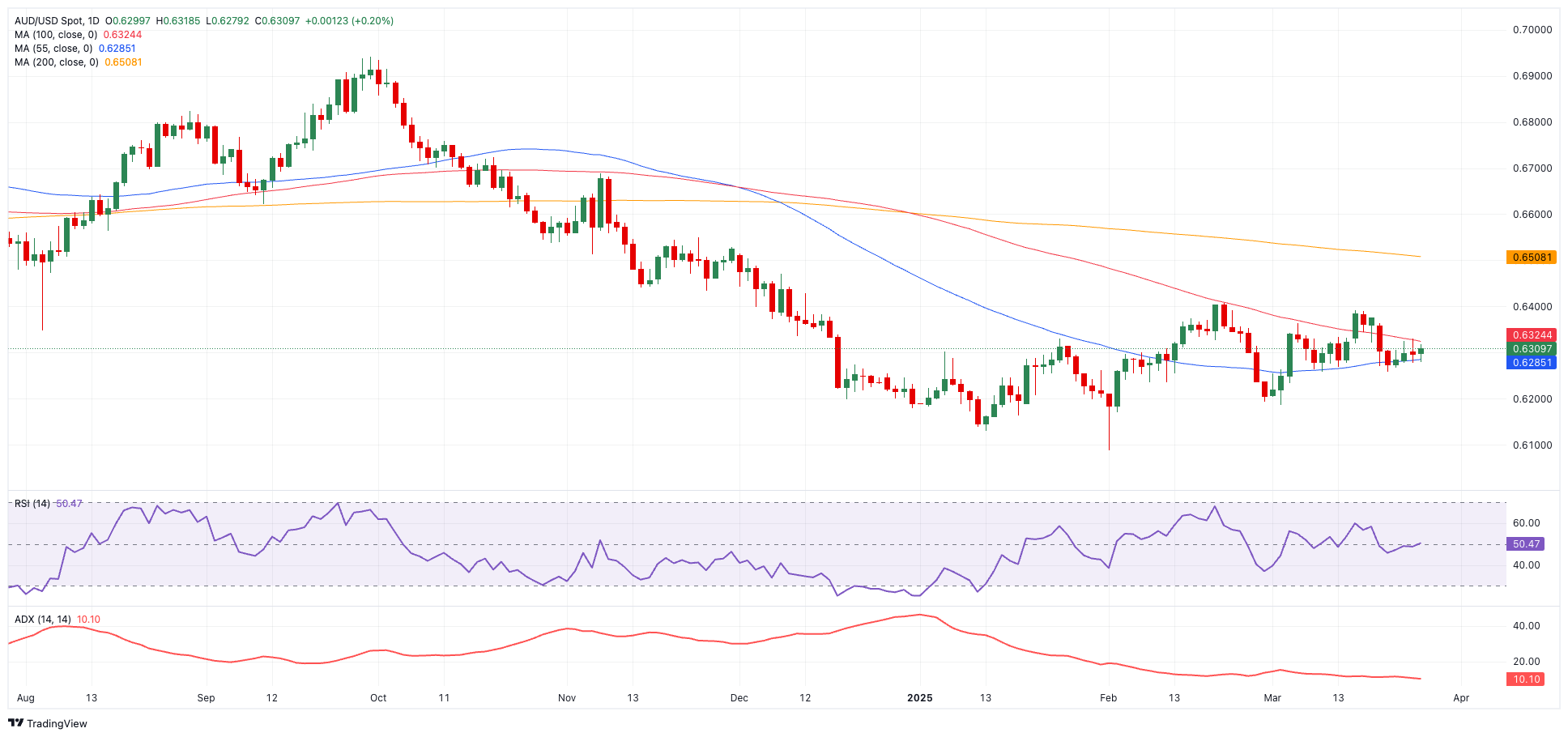- AUD/USD advanced modestly, reclaiming the key 0.6300 mark and above.
- The US Dollar faced renewed downside pressure on US economy concerns.
- Markets’ attention is expected to be on the release of US PCE on Friday.
The Australian Dollar (AUD) managed to cling to small gains on Thursday, with AUD/USD orbiting around the key 0.6300 zone amid a choppy day while extending the weekly consolidative range.
The move higher in AUD/USD was largely driven by renewed weakness in the US Dollar (USD), which succumbed to renewed selling pressure amid mounting trade uncertainty and jitters around the health of the US economy. That said, the US Dollar Index (DXY) returned to the low-104.00s following weekly tops near 104.70.
Furthermore, traders are increasingly weighing the possibility that the Federal Reserve (Fed) could maintain its restrictive stance this year, but lingering trade anxieties as well as speculation over a potential US slowdown have injected fresh volatility in the Greenback’s price action.
Risk sentiment on edge as tariff fears return
Despite bouts of optimism, the spectre of further US trade action continues to cast a long shadow. Any additional tariffs could trigger tit-for-tat responses from key trading partners, stirring market volatility and dampening risk appetite.
The Aussie, being highly sensitive to global risk sentiment and China’s commodity demand, remains especially vulnerable. Any slowdown in Chinese growth could ripple through Australia’s economy, pressuring both GDP and the currency.
According to latest news, President Trump has announced 25% tariffs on US imports of automobiles, while the deadline for reciprocal tariffs continues to loom closer.
Fed walks a tightrope
The Federal Reserve, meanwhile, finds itself at a crossroads. Trade tensions risk fanning inflation, potentially justifying a longer tightening cycle. At the same time, signs of a cooling US economy argue for caution—despite the still-resilient labour market.
Last week, the Fed held rates steady at 4.25–4.50% and signalled a wait-and-see approach. Chair Jerome Powell emphasised patience, even as the Fed’s updated projections reflected lower growth and slightly higher inflation, with tariffs cited as a key inflationary force.
RBA waits on inflation clarity
On the other side of the Pacific, the Reserve Bank of Australia (RBA) trimmed its policy rate by 25 basis points to 4.10% last month. Governor Michele Bullock stressed that future moves would depend heavily on inflation data, while Deputy Governor Andrew Hauser warned against expecting a cascade of cuts.
Minutes from the RBA’s meeting revealed a close call between a pause and a smaller cut, with officials ultimately choosing caution. Australia’s robust labour market allowed for flexibility, but February’s surprise drop in employment (–52.8K) and a steady 4.1% unemployment rate raised some eyebrows.
Meanwhile, monthly inflation metrics showed easing: the Weighted Mean CPI dipped to 2.4%, and the Trimmed Mean CPI softened to 2.7% in Q4. These align with RBA forecasts, though the central bank tends to lean more on quarterly readings for policy decisions.
Markets are largely pricing in a rate cut by July, but expectations are creeping forward—nearly 70% now anticipate a move as early as May.
Speculative sentiment sours on AUD
Speculative positioning reflects the bearish tilt. According to the latest CFTC data, net shorts on the Aussie climbed to a multi-week high of around 70.5K contracts as of March 18. Bearish bets have built steadily since mid-December, fuelled by escalating tariff risks.
AUD/USD Technical Picture
- Upside Potential: A clean break above the 2025 high at 0.6408 (Feb 21) could open the door toward the 200-day SMA at 0.6511. Beyond that, the November 2024 high of 0.6687 is the next major resistance.
- Downside Risk: Should sellers retake control, immediate support lies at the March low of 0.6186 (Mar 4). Below that, look for a test of the 2025 trough at 0.6087, and potentially the key psychological level at 0.6000.
- Momentum Signals: The RSI hovering near 50 hints at balanced—though slightly bullish—momentum, while a low ADX below 10 suggests the trend lacks conviction for now.
AUD/USD daily chart

Information on these pages contains forward-looking statements that involve risks and uncertainties. Markets and instruments profiled on this page are for informational purposes only and should not in any way come across as a recommendation to buy or sell in these assets. You should do your own thorough research before making any investment decisions. FXStreet does not in any way guarantee that this information is free from mistakes, errors, or material misstatements. It also does not guarantee that this information is of a timely nature. Investing in Open Markets involves a great deal of risk, including the loss of all or a portion of your investment, as well as emotional distress. All risks, losses and costs associated with investing, including total loss of principal, are your responsibility. The views and opinions expressed in this article are those of the authors and do not necessarily reflect the official policy or position of FXStreet nor its advertisers. The author will not be held responsible for information that is found at the end of links posted on this page.
If not otherwise explicitly mentioned in the body of the article, at the time of writing, the author has no position in any stock mentioned in this article and no business relationship with any company mentioned. The author has not received compensation for writing this article, other than from FXStreet.
FXStreet and the author do not provide personalized recommendations. The author makes no representations as to the accuracy, completeness, or suitability of this information. FXStreet and the author will not be liable for any errors, omissions or any losses, injuries or damages arising from this information and its display or use. Errors and omissions excepted.
The author and FXStreet are not registered investment advisors and nothing in this article is intended to be investment advice.
Recommended Content
Editors’ Picks

EUR/USD turns lower to near 1.0800 ahead of German inflation data
EUR/USD has come under fresh selling and trades near 1.0800 in European trading on Monday. The pair feels the heat from a modest US Dollar comeback while Euro buyers stay cautious ahead of Germany's prelim inflation data and Trump's reciprocal tariff announcement.

Gold sits at record highs above $3,100 amid tariff woes
Gold price holds its record-setting rally toward $3,150 in European trading on Monday. The bullion continues to capitalize on safe-haven flows amid intesifying global tariff war fears. US economic concerns weigh on the US Dollar and Treasury yields, aiding the Gold price upsurge.

GBP/USD holds lower ground below 1.2950 amid tariff woes
GBP/USD has returned to negative territory in the European session on Monday. Concerns that US President Donald Trump's tariffs will ignite inflation and dampen economic growth have helped revive the havem demand for the US Dollar, weighing down on the pair.

Seven Fundamentals for the Week: “Liberation Day” tariffs and Nonfarm Payrolls to rock markets Premium
United States President Donald Trump is set to announce tariffs in the middle of the week; but reports, rumors, and counter-measures will likely dominate the headline. It is also a busy week on the economic data front, with a full buildup to the Nonfarm Payrolls (NFP) data for March.

US: Trump's 'Liberation day' – What to expect?
Trump has so far enacted tariff changes that have lifted the trade-weighted average tariff rate on all US imports by around 5.5-6.0%-points. While re-rerouting of trade will decrease the effectiveness of tariffs over time, the current level is already close to the highest since the second world war.

The Best brokers to trade EUR/USD
SPONSORED Discover the top brokers for trading EUR/USD in 2025. Our list features brokers with competitive spreads, fast execution, and powerful platforms. Whether you're a beginner or an expert, find the right partner to navigate the dynamic Forex market.